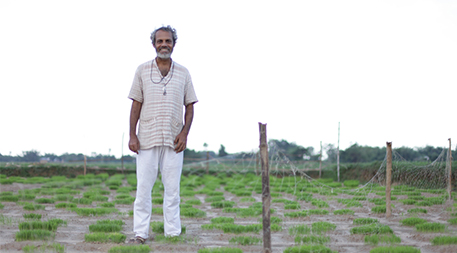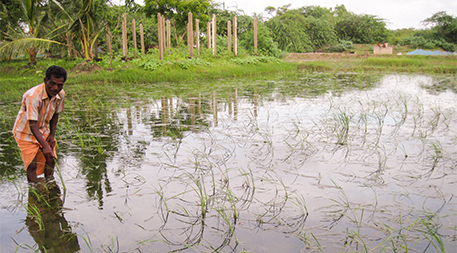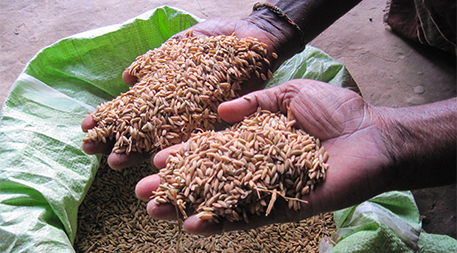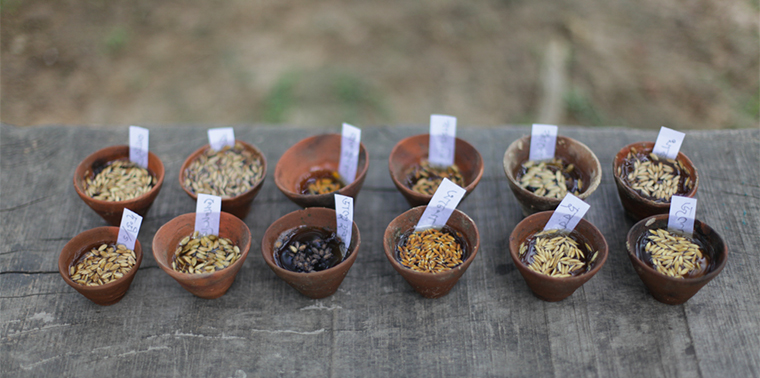February 9, 2015 — In May 2009, Cyclone Aila wreaked havoc in eastern India. Clocking in at speeds of over 120 kilometers per hour (75 mph), Aila hit the Sundarbans, the largest continuous block of mangrove forest in the world, located in the Ganga-Brahmaputra tidal delta on the Bay of Bengal.
The storm killed hundreds of people and livestock, damaged close to a million houses, and washed away roads. Heavy winds and high waves breached the mud embankments that protected the islands. This brought in a deluge of salt water from the Bay of Bengal, flooding villages, turning drinking water brackish and affecting nearly 125,000 hectares (309,000 acres) of cropland.

Debal Deb, founder of the Vrihi seed bank in West Bengal, brought new hope in the form of salt-tolerant indigenous rice to the Sundarbans after farmlands were flooded by a 2009 storm. Photo by Jason Taylor.
As floodwaters subsided in the wake of the storm, thin white lines of salt appeared in the soil. The modern, high-yielding varieties of rice that had been cultivated there previously, could not grow in this salt-encrusted soil. For the rice-dependent agrarian inhabitants of the delta, this was a cause for serious concern.
A month after the catastrophe, Debal Deb, a plant scientist and founder of Vrihi, a non-governmental rice seed bank, visited three Aila-struck villages in the Sundarbans. He brought with him four varieties of indigenous rice from his own seed bank — Talmugur, Lal Getu, Sada Getu and Nona Khirish — that could tolerate high levels of salinity in the soil.
Deb had collected these salt-tolerant varieties from Sundarban farmers back in 1997. On his seed farm, he had managed to double the salt-tolerance limit of two of the varieties — Lal Getu and Sada Getu — by meticulous selective breeding of the crop at different salinity levels.
Most traditional rice varieties, including the ones Deb carried that day, are adapted to local climates and regions. But with the advent of modern high-yielding varieties of rice, local varieties became disused, and many were subsequently lost. Fortunately, a handful of rice conservationists in India have managed to save some of them.
Deb’s seed bank, for instance, holds more than 1,000 different kinds of indigenous rice, which he grows on his 2.3-acre farm and distributes among farmers for free. Some of these varieties, like the ones he reintroduced to the Sundarbans, are salt tolerant. Others can withstand long bouts of drought or floods.
When Deb brought the four salt-tolerant varieties to the Sundarbans in June of 2009, only one was still being grown by local farmers. The other three remained only in their memories.
The farmers were initially suspicious of the salt-tolerant varieties, Deb says. “They had received many seeds from the government, but none of them had grown in their saline soil after Aila. When they saw that the seeds I gave them were germinating, they were very happy.”
That year, Deb managed to distribute the four varieties to 11 eager farmers.

Salt-tolerant rice has helped Sundarbans farmer Bhagyadhar Pramanik maintain production after tropical storm Aila inundated the farmland with salt water. Photo courtesy of ENDEV.
He returned the following year, with a Kolkata-based organization called ENDEV – A Society for Environment and Development. Asish Ghosh, president of ENDEV, had scouted for and acquired more seeds of the salt-tolerant varieties from different sources. In 2010 and 2011, ENDEV worked with Deb and five local organizations to distribute these seeds to the Sundarbans farmers.
“These varieties are financially lucrative,” explains Ghosh. “They do not require costly inputs of fertilizers or pesticides, and produce better quality straw for cattle feed and roofing of houses.”
In 2013, Deb reintroduced two additional varieties of rice, Matla and Hamilton, which he received from other plant scientists in West Bengal. According to a report by WWF-India, these varieties have such high salt tolerance that farmers once cultivated them in areas without any embankments to keep salt water out.
As of 2014, more than 70 Sundarbans farmers are growing the six salt-tolerant varieties, Deb says.
Radheshyam Das, a 52-year-old rice farmer in Jhupkhali village in the Sundarbans, is happy with his rice yield, which he measures in 1/3-acre (1/8-hectare) units of land area called bighas. “Since Aila, my rice production with high-yielding varieties fell to about two bags of rice per bigha,” he says. “Last year, with the salt tolerant variety, I had a harvest of seven bags per bigha.”
In another village on Mousuni Island in the Sundarbans, farmer Sindhupada Middya experimented with a salt-tolerant variety and a modern variety. The plot of land he grew them in lay close to an embankment and would frequently be inundated by salt water during high tides. While the salt-tolerant variety yielded 240 kilograms of rice from less than one-tenth of a hectare (one-fifth of an acre) of land, the high-yielding variety produced nothing.

Sundarbans farmers literally sing the praises of indigenous salt-tolerant rice, which has boosted their resilience to a changing climate. Photo courtesy of ENDEV.
His success encouraged almost 40 other farmers on the island to adopt these salt-tolerant varieties, according to Soma Saha, member of the WWF-India team that has been introducing these rice varieties as part of its climate change adaptation initiatives.
In another part of the Sundarbans, a group of farmers have even composed a folk song that celebrates the traditional seeds. The song talks about the resilience of the seeds, the happiness they have brought and why others should use them.
By combining science with traditional knowledge, Ghosh says, farmers will be able to continue to produce food for themselves and their communities.As our planet warms in the decades to come, rising sea level, changing rainfall pattern and increasing frequency of cyclones such as Aila are expected to continue to erode and submerge islands in the Sundarbans. And the resulting salt intrusion is expected to continue to render crop fields unsuitable for modern rice varieties.
But by combining science with traditional knowledge, Ghosh says, farmers will be able to continue to produce food for themselves and their communities.
“We did not develop these varieties,” Ghosh says. “The farmers did, many many years ago. Some of us simply rediscovered their 100 year-old traditional knowledge, located the seeds and motivated the farmers to start using them again.” ![]()
Editor’s note: Shreya Dasgupta produced this article as a participant in the Ensia Mentor Program. Her mentor for the project was award-winning environmental and science journalist Michelle Nijhuis.
Ensia shares solutions-focused stories free of charge through our online magazine and partner media. That means audiences around the world have ready access to stories that can — and do — help them shape a better future. If you value our work, please show your support today.
Yes, I'll support Ensia!
